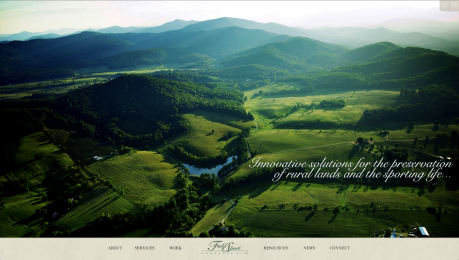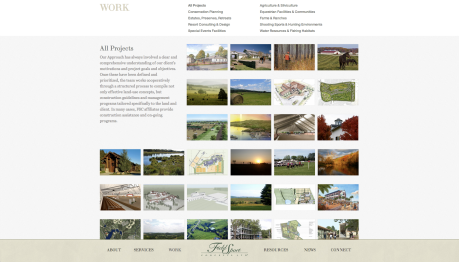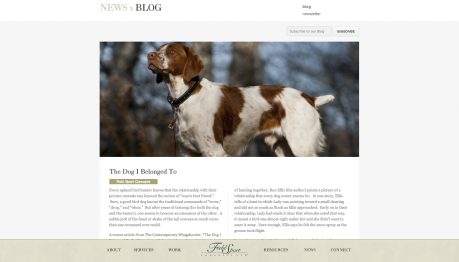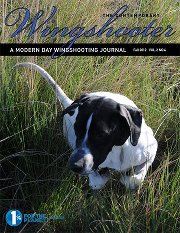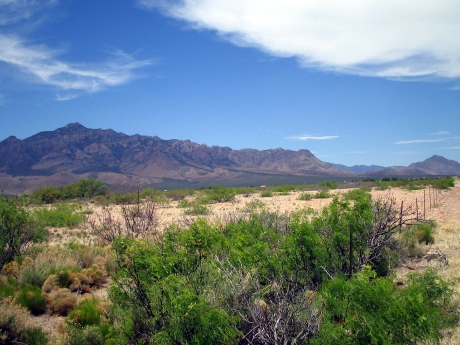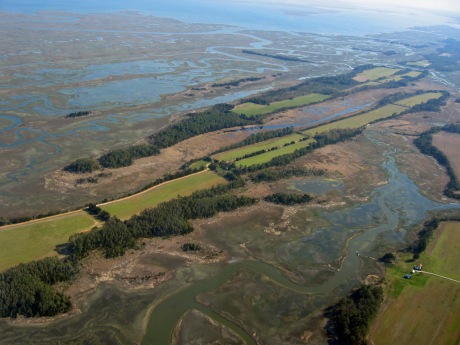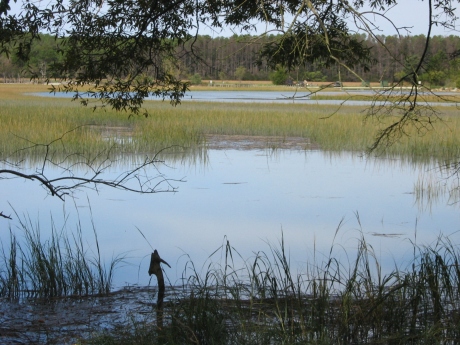Created and Restored Wetlands are Unexpectedly Efficient for Storing Carbon
September 24, 2013
FSC Affiliate Trout Headwaters Inc. recently posted the following.
At THI we work hard to raise awareness about the ecological value of wetlands. The ecological services wetlands provide, including water storage, water filtration, flood prevention, and aquatic habitat are becoming better understood and appreciated, however, another critical ecological service has, until now, been overlooked. The American Society of Agronomy reports wetlands also excel at pulling carbon dioxide out of the air and holding it long-term in soil.
According to Bill Mitsch, director of the Everglades Wetland Research Park at Florida Gulf Coast University and an emeritus professor at Ohio State University, writing in the July-August issue of the Journal of Environmental Quality with co-author Blanca Bernal, two 15-year-old constructed marshes in Ohio accumulated soil carbon at an average annual rate of 2150 pounds per acre—or just over one ton of carbon per acre per year.
The rate was 70% faster than a natural, “control” wetland in the area and 26% faster than the two were adding soil carbon five years ago. And by year 15, each wetland had a soil carbon pool of more than 30,000 pounds per acre, an amount equaling or exceeding the carbon stored by forests and farmlands.
What this suggests, Mitsch says, is that researchers and land managers shouldn’t ignore restored and manmade wetlands as they look for places to store, or “sequester,” carbon long-term. When created wetlands are discussed in agricultural circles, it’s almost always in the context of water quality. “So, what I’m saying is: let’s add carbon to the list,” Mitsch says.
To discuss your wetland creation or restoration project contact THI today
The Dog I Belonged To
September 19, 2013
Every upland bird hunter knows that the relationship with their pointer extends way beyond the notion of “man’s best friend.” Sure, a good bird dog knows the traditional commands of “come,” “drop,” and “whoa.” But after years of training (for both the dog and the hunter), one seems to become an extension of the other. A subtle jerk of the head or shake of the tail conveys so much more than any command ever could.
A recent article from The Contemporary Wingshooter, “The Dog I Belonged To,” offers a beautiful story about the author’s years with his first bird dog, a Brittany Spaniel by the name of Lady. Offering an overview of his efforts to train Lady (and realizing he had just as much to learn) as well as their many years of hunting together, Ron Ellis (the author) paints a picture of a relationship that every dog owner yearns for. In one story, Ellis tells of a hunt in which Lady was pointing toward a small clearing and did not so much as flinch as Ellis approached. Early on in their relationship, Lady had made it clear that when she acted that way, it meant a bird was almost right under her and she didn’t want to scare it away. Sure enough, Ellis says he felt the snow-spray as the grouse took flight.
In another anecdote, Lady once fell down a well during a hunt. Ellis’s friends “graciously” offered to lower him head first into the well. As his friends said, “Hey, it’s your dog.” After coming back up, one of the friends’ dogs fell into the same well. The friend looked at Ellis and said, “Hey, you’re already wet.” Back down the well he went.
Whether you’ve ready every issue of The Contemporary Wingshooter or this is your first introduction to it, we encourage you to check out their many beautifully written stories about everything wingshooting.
In the meantime, share your pictures of you and your pointer on our Facebook page!
Beekeeping as an Agricultural Use
September 12, 2013
The following story comes from our friends at Plateau Land and Wildlife Management and represents a great opportunity to establish “agricultural use” on smaller properties (5-20 acres) that would otherwise be too small for grazing livestock.
By Shane Kiefer, CWB, Senior Wildlife Biologist at Plateau
A new addition to the definition of “Agricultural Use” in the Tax Code (Sec.23.51(2)) makes beekeeping a qualified agricultural operation for property tax purposes. There are some restrictions: the bees must be used for pollination or production of a tangible product with commercial value (e.g. honey, wax, etc.) and the land used for such purposes must be 5-20 acres in size. Note that it does not require commercial production, which means you do not have to actually sell the products, unlike in other forms of agricultural use.
This is a potentially valuable class of agricultural production for landowners with 5-20 acre properties who want to establish their open-space (Ag) valuation without having to graze livestock on such a small area, which is unsustainable pretty much anywhere in Central or West Texas.
Wildlife management valuation is a great option for these properties but, as you know, it only applies to properties that are currently qualified open-space land, and you cannot yet build a 5 year history to apply for open-space based on doing wildlife activities. Beekeeping gives a new option for small acreage landowners who need to establish a 5-year agricultural history to acquire their open-space valuation.
While the Tax Code now allows for this type of agricultural use, the intensity standards and requirements in each appraisal district are not necessarily clearly defined. Appraisers around the state are no doubt working to outline local intensity standards. That means that you should not rush out and buy hives and a beekeeper suit until you speak with your appraisal district about the expected requirements.
As always, Plateau is here to help you manage the process of building up your agricultural history and working with the appraisal district to determine what is needed for your operation to be a success. If any of you have already had success with this type of operation in your county, please give them a call. They would love to hear your story.
Georgia Coast Initiative
August 30, 2013
This comes from our friends at the Southern Environmental Law Center.
Admired worldwide for its stunning beauty and rich biological diversity, the Georgia coast encompasses a lacework of barrier islands, mud flats, tidal creeks, blackwater rivers, freshwater wetlands, and some 378,000 acres of salt marsh. Though it has largely escaped the ravages of massive resort development, this special region faces a perfect storm of threats, including lax enforcement of environmental laws, the sell-off of timberlands to developers, and intense growth pressures that continue to mount even in today’s weak economy.
These pressures have brought the Georgia coast to a tipping point. If we fail to counter them, some of America’s most cherished natural resources will be lost forever.
Saving the Georgia coast is one of the toughest conservation challenges we face in the South today, and it is also one of SELC’s highest priorities. To defend this ecological gem, we have launched a comprehensive initiative that draws on all our skills and expertise.
– What’s at Stake Many people are surprised to learn that Georgia harbors one-third of the salt marsh remaining on the East Coast. Most of the marsh is held by the state—not as the state’s own property, but “in trust for the public.” Thus, the marshes are a public resource, and one of incredible value. These vast expanses of grasses and meandering tidal creeks are not only beautiful; they serve as nurseries for marine life and as vital buffers against storms.
Dotting the marsh are more than 1,650 islands, called “marsh hammocks,” that provide a secluded sanctuary for wildlife. Sheltering the marshes are 14 barrier islands rimmed with more than 100 miles of white sandy beaches.
Inland wetlands along the coast are an important resource for people and wildlife alike: they improve water quality, reduce flooding, and provide habitat for an array of wild creatures. The ocean waters off the Georgia coast are prime calving grounds for the North Atlantic right whale—one of the rarest marine mammals on the planet and one of several endangered species that make their home in this region, including manatees, wood storks, and sea turtles, among others.
For more information about SELC’s Georgia Coast Initiative visit their website at: http://www.southernenvironment.org
photo provided by Robert LLewellyn
Restoring Water to the Southwest
October 16, 2012
If you had been raised as a member of the Upper East Side of Manhattan’s high society and made a career as a painter, what sorts of challenges would you pursue as you neared the age of 60?
How about converting a couple dry and barren ranches in the American Southwest and Mexico into thriving ecosystems?
Well that’s exactly what Valer Austin did 13 years ago. Now at the age of 72, Valer is as energetic as she has ever been, especially when it comes to talking about water on her land. You see, when Valer and her husband, Josiah, bought their first ranch, the land was parched and supported only the hardiest of plant species. Surface streams were nonexistent.
Though the Austins intended to use the ranch as a vacationing spot, they quickly realized that owning a ranch was a full-time effort, and one they were more than happy to embrace. Their methods for restoring the land, however, were largely an accident. Hoping to prevent the occasional rainstorms from pouring across a section of road on the property, Josiah built a couple small rock dams, called trincheras. He and Valer quickly noticed that silt was piling up behind the rocks along with puddles that stayed around long after the rain. What was truly amazing, though, was when grasses started growing out of the moist silt! Valer and Josiah quickly realized that a series of trincheras all around their property could slow the pace of rainfall runoff and allow it provide both nutrients and moisture to their land.
Now, 13 years and over 20,000 trincheras later (plus tree planting, some heavy engineering, and a number of other efforts), water has become a common site all over their property. Species that had fled long ago are returning and enjoying the reclaimed lushness of the land. Researchers, photographers, and government officials are regular visitors to the land, seeking to study the impact of the Valer’s efforts and to teach others how relatively primitive solutions can have such a profound effect.
We encourage you to read more about this incredible story by checking out CNN’s article “An Amateur Rancher Brings the Wastelands of the Southwest Back to Life.”
Featured Project: Brickhouse Neck Farm
October 11, 2012
Located along the barrier islands between the Chesapeake Bay and the Atlantic Ocean, Brickhouse Neck is not only a beautiful place but a unique ecosystem as well. The property is comprised of farm fields and salt marsh interspersed with tidal creeks, mud flats, shallow bays and ponds. Brickhouse Neck and its family of barrier islands is a fragile landscape that comprises the longest stretch of coastal wilderness remaining on the Atlantic Coast of the United States.
Beginning in 1969, The Nature Conservancy bought 14 of the islands as the core of the Virginia Coast Reserve in an effort to ward off development proposals. Our work at Brickhouse Farm was intended to help The Nature Conservancy broaden its protection of this vital ecosystem. We worked with our client to prepare a by-right development plan to assure that the land would be placed under conservation easement and preserved long into the future.
If you have been considering taking advantage of the financial incentives of placing a conservation easement on your land, or are interested in learning more, don’t hesitate to contact us!
After the Rains
October 9, 2012
After months of waiting, the rains finally fell over West Texas. Five inches in one weekend, in fact! The reservoir supplying water for San Angelo and a number of other nearby communities swelled from 12 percent of capacity to 26 percent full in just four days. As one resident put it, though, “We’re pretty excited. But we’re not out of the drought.”
Indeed, some 66 percent of Texas remains in drought. And while communities were given a temporary reprieve from the lack of rain, public officials are still facing agonizing decisions about how best to preserve quality of life while protecting this vital resource.
In the past, communities responded by building more and bigger reservoirs to ensure larger reserves in the event of water shortages. However, it has become evident that with the hot, dry temperatures that characterize the Texan climate, more water generally evaporates from the reservoirs in a given year than people use. Indeed, according to Mayor Alvin New of San Angelo, “our biggest enemy is actually evaporation.”
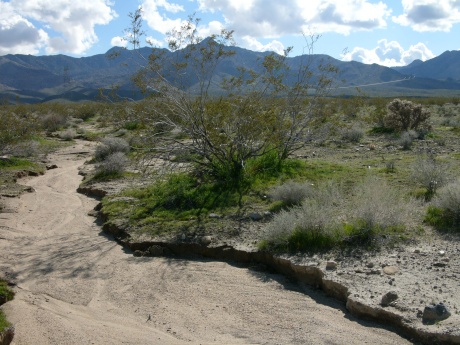
As a result of the drought, many communities are thought to be only 180 days from running out of water. Photo courtesy of gin_e.
This time, officials are placing their bets on new pipelines to tap vast underground aquifers. However, this approach has its own concerns. The aquifers must be protected from pollutants that could contaminate drinking supplies while also ensuring that the sources of these aquifers do not dry up. Though many approaches to address these problems have been proposed, we are particularly supportive of San Antonio’s strategy, which focuses on protecting natural processes rather than large infrastructure projects. (To read more on San Antonio’s program, read our post on Radical Conservation).
If you’ve been experiencing water shortages, let us know how your community has responded!
Modern Conservation
September 12, 2012
When Yellowstone National Park was established in 1872, it was created in a spirit of conservation known as “fortress conservation” or “protectionism.” The idea behind this approach to conservation preached that the best way to preserve valuable lands and biodiversity was to leave it in as natural a state as possible. This strategy enabled the creation of 53 national parks as well as millions of acres of protected public land.
Today, however, the prevailing approach to conservation has shifted. Large-scale, government-led efforts to protect large swaths of land against development certainly still occur, but they are no longer the primary driver. Instead, the leaders of the modern conservation movement are private citizens and organizations focusing on smaller parcels of land but in greater numbers. While “fortress conservation” still takes place, the primary approach to conservation has shifted to one that takes into account the ecological, economic, and intrinsic values of the land and its resources. In other words, the focus is on “sustainable use.”
Last month, a collection of government, private industry, and non-profit agencies came together to conserve a 3,000-acre tract of land in eastern Georgia. Located next to an Army base, there was concern that the land might be developed in ways that were incompatible to the base’s needs. Held up as “a great example of modern conservation” by Andrew Schock, Georgia State Director for the Conservation Fund, the land was put under a conservation easement that will allow for a sustainable forestry operation and access to local hunt clubs. With this approach, the adjacent Army base will no longer have to worry about incompatible development on the land, and the land will still provide jobs and recreational ground to locals.
“This is an example of what can be achieved when government, private industry, and non-profits coordinate their efforts,” said Congressman Jack Kingston. “The agreement will conserve land, create jobs, increase recreational access and provide Fort Stewart with buffer without negatively impacting the local tax base. I commend the parties involved and hope we can work toward similar agreements where they would be mutually beneficial.”
To read more about this exceptional effort, we encourage you to check out The Conservation Fund’s website.

With modern conservation techniques, such as those employed at The Fork Farm and Stables, prime hunting grounds will be protected for sporting enthusiasts.
